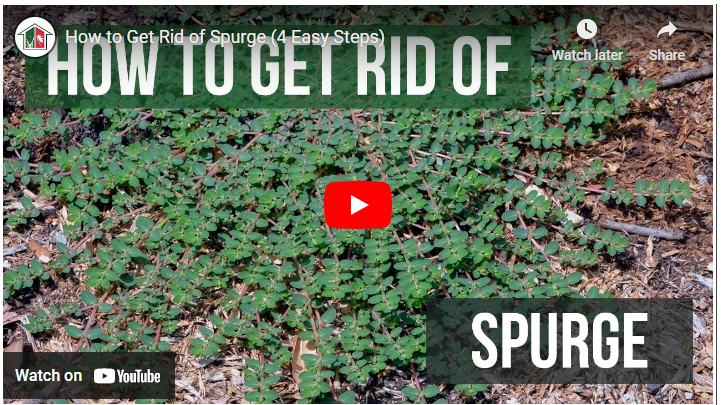Spurge is a common and persistent weed that can quickly take over lawns and gardens if left unchecked. To effectively control spurge, it is essential to use herbicides that specifically target this troublesome plant. In this article, we will explore the top 10 best herbicides for spurge control, discussing their effectiveness, safety, and application methods.
Top 10 Best Herbicides for Spurge
Spurge, scientifically known as Euphorbia, is a broadleaf weed that thrives in various conditions, making it a common nuisance for homeowners and gardeners. Its fast-spreading nature and ability to adapt to different environments make it a challenging weed to eradicate. Fortunately, herbicides offer an effective solution for controlling spurge and reclaiming your lawn or garden.
Read Also: Top 15 Best Herbicides for St Augustine Grass
1. Glyphosate-based Herbicides
Glyphosate-based herbicides are widely recognized for their effectiveness in controlling various weeds, including spurge. Glyphosate works by inhibiting a crucial enzyme necessary for plant growth, ultimately leading to the death of spurge. These herbicides are available in various formulations, including concentrates, ready-to-use sprays, and granules, providing flexibility in application methods.
Read Also: Top Best Herbicides For Sugarcane
One of the advantages of glyphosate-based herbicides is their broad-spectrum control, meaning they can target a wide range of weeds in addition to spurge. However, it’s important to note that glyphosate can also affect desirable plants, so caution must be exercised during application. To mitigate the risk of harming surrounding vegetation, it’s recommended to apply glyphosate-based herbicides selectively and avoid spraying on windy days to prevent drift.
Read Also: Top 10 Best Herbicides for Dandelions
Some popular glyphosate-based herbicides for spurge control include Roundup and Ortho GroundClear. These products are widely available and have been proven effective in combating spurge infestations. Always follow the instructions provided on the product label for proper mixing ratios, application rates, and safety precautions.
Read Also: Top 10 Best Herbicides for Clover
2. 2,4-D-based Herbicides
Another group of herbicides commonly used for spurge control are 2,4-D-based herbicides. These herbicides contain 2,4-dichlorophenoxyacetic acid as their active ingredient and are known for their selective control of broadleaf weeds, including spurge. 2,4-D works by mimicking plant growth hormones, causing uncontrolled growth and eventually killing the target weed.
When using 2,4-D-based herbicides, it’s crucial to apply them at the correct stage of spurge growth for optimal effectiveness. Early stages of spurge development are ideal for herbicide application as the plants are more susceptible to the chemical’s effects. Additionally, care should be taken to prevent overspray or drift onto desirable plants to avoid damage.
Read Also: Top 10 Best Herbicides for Japanese Knotweed
Weed-B-Gon and Trimec are popular 2,4-D-based herbicides that have proven efficacy in spurge control. These products come in different formulations, including concentrates and ready-to-use sprays, allowing for convenient and targeted application.
3. Dicamba-based Herbicides
Dicamba-based herbicides are another effective option for spurge control. Dicamba disrupts plant growth by mimicking auxin, a plant hormone responsible for cell elongation. By interfering with auxin activity, dicamba causes abnormal and uncontrolled growth in spurge, leading to its eventual demise.
Read Also: Top 10 Best Herbicides for Creeping Charlie
Dicamba-based herbicides, such as Banvel and Clarity, offer selective control of spurge while minimizing damage to desirable grasses. These herbicides are available in various formulations, including liquid concentrates and ready-to-use sprays. Care should be taken to follow the product instructions carefully, as dicamba can be harmful to certain plant species.
Read Also: Top 10 Best Herbicides for Thistles
4. Triclopyr-based Herbicides
Triclopyr-based herbicides are particularly effective in targeting woody plants, including spurge. Triclopyr works by disrupting the plant’s ability to produce certain growth-regulating hormones, leading to the withering and eventual death of spurge. These herbicides are available in both selective and non-selective formulations.
Read Also:Top 10 Best Herbicides for Lawns
Selective triclopyr-based herbicides, such as Brush-B-Gon and Turflon Ester, are designed to control spurge without causing harm to surrounding desirable plants. Non-selective triclopyr-based herbicides, such as Garlon 4 and Remedy Ultra, are suitable for use in areas where complete vegetation removal is desired. However, caution should be exercised to prevent accidental contact with desirable plants.
Read Also: The Top 10 Best Herbicides for Poison Ivy
5. Quinclorac-based Herbicides
Quinclorac-based herbicides are known for their effectiveness in controlling a variety of broadleaf weeds, including spurge. Quinclorac works by disrupting the growth process of weeds, leading to stunted development and eventual death. These herbicides are particularly useful in lawns and turf areas where spurge infestations are common.
Popular quinclorac-based herbicides for spurge control include Drive XLR8 and Quinclorac 75 DF. These products are available in liquid concentrate form and can be mixed with water for easy application. It’s important to follow the recommended application rates and safety guidelines specified by the manufacturer to achieve optimal results.
Read Also: Top 10 Best Herbicides For Weed Control
Other Effective Herbicides for Spurge Control
In addition to the herbicides mentioned above, there are several other effective options for spurge control. These herbicides may contain different active ingredients and offer specific advantages depending on the situation.
Sulfentrazone: This herbicide provides post-emergent control of spurge and other broadleaf weeds. It can be found in products like Dismiss and Sedgehammer.
Read Also: Top 10 Best Herbicides for Wild Violets
Metsulfuron-methyl: Herbicides containing metsulfuron-methyl, such as Escort XP and Cimarron Plus, offer effective control of spurge and other problematic weeds. They are commonly used in agricultural and non-crop areas.
Prodiamine: This pre-emergent herbicide, available in products like Barricade and Crabgrass Preventer, forms a barrier in the soil to prevent spurge seeds from germinating.
Dithiopyr: Herbicides containing dithiopyr, such as Dimension and Sta-Green Crabgrass Preventer, provide pre-emergent and post-emergent control of spurge and other weeds.
It’s important to carefully read the product labels and select the herbicide that best suits your specific needs, taking into account factors such as the target area, desired control method, and compatibility with other plants.
Factors to Consider When Choosing Herbicides
Before delving into the specific herbicides, it’s crucial to consider a few factors when selecting the most suitable option for spurge control. These factors include safety precautions, environmental impact, targeted effectiveness, and application methods. Taking these aspects into account will help ensure successful spurge eradication without causing harm to desirable plants or the environment.
Best Practices for Herbicide Application
To achieve the best results when using herbicides for spurge control, it’s essential to follow these best practices:
Identify the spurge: Properly identify spurge to ensure you are targeting the correct weed. Spurge has distinctive characteristics, including prostrate growth, small oval-shaped leaves, and milky sap.
Timing is key: Apply herbicides when spurge is actively growing and in the early stages of development for optimal effectiveness.
Read and follow instructions: Carefully read the product label for information on proper mixing ratios, application rates, safety precautions, and any specific instructions for spurge control.
Protect desirable plants: Take precautions to prevent herbicide drift or overspray onto desirable plants. Use shields or barriers if necessary and avoid application on windy days.
Uniform coverage: Ensure thorough and uniform coverage of the spurge-infested areas. Pay attention to areas where spurge is more concentrated.
Safety first: Always wear appropriate protective clothing, such as gloves, long sleeves, pants, and eye protection, when handling and applying herbicides. Follow all safety guidelines provided by the manufacturer.
Adhere to restrictions: Be aware of any restrictions on herbicide application in your area, such as environmental regulations or restrictions on specific locations like water bodies.
Follow-up maintenance: Monitor the treated area and reapply herbicides as necessary to control any new spurge growth or regrowth.
By following these best practices, you can maximize the effectiveness of herbicides while minimizing the potential impact on the environment and surrounding vegetation.
Are herbicides safe to use around pets?
When used according to the product instructions, herbicides are generally safe for pets. However, it’s important to keep pets away from treated areas until the herbicide has dried or absorbed into the soil. Consult the product label or contact the manufacturer for specific guidance on pet safety.
Can herbicides kill other plants along with spurge?
Some herbicides, particularly non-selective ones, can harm or kill desirable plants if not applied carefully. To protect surrounding vegetation, consider using selective herbicides or employ targeted application methods such as spot treatment. Always read and follow the instructions on the product label to minimize any potential damage to other plants.
How long does it take for herbicides to work on spurge?
The time it takes for herbicides to work on spurge can vary depending on the product and the stage of spurge growth. In general, visible effects may be observed within a few days to a couple of weeks. However, complete control of spurge may require multiple applications over several weeks or months. Follow the recommended application intervals specified on the product label for best results.
Can I use homemade herbicide recipes for spurge control?
While there are various homemade herbicide recipes available, it’s important to approach them with caution. Homemade herbicides may not be as effective or reliable as commercially formulated ones. Furthermore, some recipes may contain ingredients that can be harmful to the environment or cause unintended damage to desirable plants. It is generally recommended to use approved and tested herbicides for safe and effective spurge control.
Is it necessary to wear protective clothing when applying herbicides?
Yes, it is essential to wear protective clothing when applying herbicides to protect yourself from potential exposure. This typically includes gloves, long sleeves, long pants, and closed-toe shoes. Additionally, wearing eye protection and a mask can further minimize the risk of accidental contact or inhalation of herbicide sprays. Always follow the safety recommendations provided by the herbicide manufacturer to ensure your well-being during application.
Conclusion
Controlling spurge can be a challenging task, but with the right herbicides and proper application techniques, it is possible to effectively manage and eliminate this troublesome weed. The top 10 best herbicides for spurge control, including glyphosate-based, 2,4-D-based, dicamba-based, triclopyr-based, quinclorac-based, and other effective options, offer a range of choices to suit different situations and preferences.
When choosing a herbicide, consider factors such as safety precautions, environmental impact, targeted effectiveness, and application methods. Follow the instructions provided on the product label for proper mixing ratios, application rates, and safety precautions. Take care to protect desirable plants from herbicide drift or overspray, and always wear appropriate protective clothing during application.
In addition to herbicide use, maintaining a healthy lawn or garden through regular mowing, proper watering, and adequate fertilization can help prevent spurge infestations. Remember to practice good lawn and garden maintenance habits to create an environment that is less favorable for spurge growth.
If you’re unsure about which herbicide to use or how to effectively control spurge, consult with a professional landscaper or garden center for expert advice tailored to your specific needs.
By taking a proactive approach to spurge control and utilizing the best herbicides available, you can reclaim your lawn or garden from the grasp of this invasive weed and enjoy a beautiful, weed-free outdoor space.



